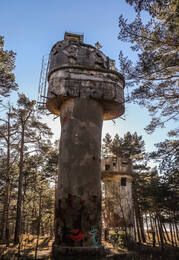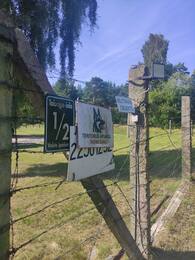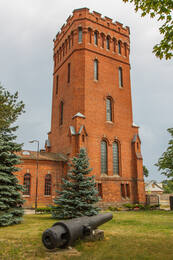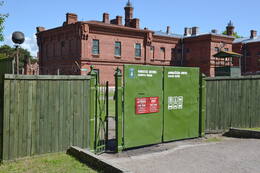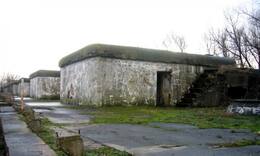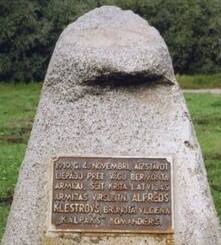Pirmasis pasaulinis karas ir nepriklausomybės kovos Pietų Latvijoje
Diena 1.
20 km
Diena tiek pavadīta Liepājā
Praktinė informacija
- Maršruts ir domāts kā padomdevējs - kā optimālāk apceļot reģionu vai valsti, vai divas valstis ar mērķi iepazīt to militāro mantojumu;
- Braucējam pašam ir jāizplāno – cik no ieteiktajiem objektiem un vietām viņš vienas dienas laikā var iepazīt;
- Pirms ceļojuma ir jānoskaidro apskates vietu (muzeju, kolekciju, fortifikācijas u.c. objektu) darba laiks;
- Vietās, kur ir iepriekšēja pieteikšanās (vietējie gidi, privātas kolekcijas, cits), ir jāpiesaka vizīte, norādot datumu un laiku. Ja ceļojums tiek atcelts, ir jāinformē pieteiktās vietas;
- Naktsmītnes ir jārezervē laicīgi. Vasaras sezonā, īpaši jūras piekrastē naktsmītnes var būt nepieejamas. Daļa no ēdināšanas uzņēmumiem ziemas sezonā var nestrādāt;
- Ceļojumam izvēlieties ne tikai vasaru, bet arī citus gadalaikus;
- Latvijas – Lietuvas – Igaunijas robežas pa autoceļiem var šķērsot brīvi bez ierobežojumiem un jebkurā diennakts laikā. Iebraucot no vienas valsts otrā ir jābūt līdzi ID kartei vai pasei;
- Apmeklējiet tūrisma informācijas centrus, kur var iegūt papildus informāciju, bukletus, kartes.
Lankytinos vietos
Karosta, the Military port of Liepāja (tour)
The Karosta is the largest historical military territory in the Baltics and occupies almost one third of the entire territory of Liepāja. The Karosta is a unique compound of military and fortification buildings on the shores of the Baltic Sea with a special meaning in the history and architecture of Latvia and the world. The Karosta features such military heritage sites as the North Pier and forts, the Redan, Karosta Prison, Karosta Water Tower, St. Nicholas Orthodox Maritime Cathedral, Oskars Kalpaks Bridge and others.
Redanas, Karosta
Redanas, arba Redanos fortas, yra Karostoje, lapkričio 14 d. gatvėje, apie 1,5 km nuo Šiaurinių fortų, gamtos rezervate „Tosmare“.
Istoriškai redanai buvo įtvirtinimų elementai, kur ilgesnės tvirtovės sienų atkarpos buvo dalijamos į trumpesnes dalis, įrengiant V formos pozicijas, nukreiptas į priešą, taip geriau apsaugant įtvirtinimų sieną. Karosto redanas yra XIX a. pabaigos Liepojos jūros tvirtovė, išsikišusi link Tosmarės ežero. Tvirtovei praradus savo, kaip tvirtovės, vaidmenį, aplink ją esantys įtvirtinimai ir fortai buvo iš dalies susprogdinti ir paversti nebenaudotinais. Tačiau Redanas išliko beveik nepaliestas.
1919 m. lapkritį, po nesėkmės Rygoje, Pavelo-Bermonto Avalovo pajėgos pradėjo intensyvų Liepojos puolimą. Mūšis vyko ir Redane, kur kovojo 80 Liepojos karinio uosto komendantūros kareivių, vadovaujamų vado leitenanto Radzinio. Lapkričio 14 d. per greitą puolimą bermontininkams pavyko užimti Redaną. Po to sekė Latvijos kariuomenės kontrataka ir Redanas buvo atsiimtas.
Birželio, liepos ir rugpjūčio mėnesiais kiekvieną dieną nuo 11.00 iki 17.00 val. Redane jūsų lauks patyręs gidas, pasiruošęs papasakoti daugiau apie Liepojos tvirtovę ir istorinius įvykius Karostoje.
Liepāja coastal artillery battery No. 2
Among the many objects of Liepāja Karosta, Liepāja coastal artillery battery No. 2 is still the most mysterious place in Liepaja. In battery no. 2, the ammunition depots of the troops of the various existing powers were always installed.
Liepaja Fortress Battery No. 2 was built further from the coastline and was protected by a high rampart. The batteries were armed with 16 11-inch (280 mm) mortars of the 1877 model. After the fortress was dismantled, ammunition warehouses were set up here. Due to the danger of explosions, the territory was closed to the public and guarded for 130 years, but now there is an exposition about the activities of the 1st Kurzeme Division Headquarters in the years 1919-1940s, as well as photo evidence of the 1st Liepāja Infantry Regiment, the 2nd Ventspils Infantry Regiment and the Kurzeme Artillery. regiment.
Karostos vandens bokštas
Vandens bokštas yra Liepojoje, Karostoje, Generolo Baložos gatvėje 29 – ten, kur gatvė susikerta su Lazaretes gatve. Vandens bokštas buvo svarbus Karostos statinys, nes tiekdavo geriamąjį vandenį beveik visai Karostos teritorijai. Tikslus vandens bokšto statybos laikas nežinomas, tačiau jis galėjo būti pastatytas 1903–1905 metais. Projektą greičiausiai parengė Sankt Peterburgo architektas Stefanas Galenzovskis.
Vandens bokštą varė garo variklis su dviem anglimi kūrenamais katilais, vienas iš jų buvo laikomas rezerve, todėl šalia bokšto yra tokio pat aukščio kaminas. Transmisija varė keturis siurblius, iš kurių du buvo laikomi rezerve. Keturi gręžiniai tiekdavo vandenį siurbliams, kurie pumpuodavo jį į rezervuarą penktame bokšto aukšte, o iš ten – į karininkų butus ir kareivinių kareivines Karostoje.
Latvijos armijai perėmus vandens bokšto valdymą, vandens bokšto valdymą perėmė ir Karo ministerija. Po Antrojo pasaulinio karo valdymą perėmė Sovietų armija. Vandens bokštas uždarytas nuo 1989 m.
Nors bokštas nebuvo karinis statinys, 1919 m. lapkritį Latvijos armija atitaisė britų karo laivų artilerijos ugnį kovoje su Bermonto kariuomenės puolimu.
https://industrialheritage.travel/lv/objects/karostas-udenstornis/51
Liepaja Fortress Battery No 6
The 6th Battery, which is the best preserved fortification structure today, was planned to protect the coast of Liepaja Fortress south of the Trade Canal. The battery was to house four 6-inch (152 mm) guns of the 1892 model of the Canet system, eight 11-inch (280 mm) guns of the 1887 model, nine mortars of various calibres and two 57 mm Nordenfeld anti-tank guns. At the beginning of the First World War, after the fortress had already been dismantled, Battery 6 still contained the armament used in April 1915, when the German Navy attempted to land a landing at the South Pier.
In the early 1920s, the construction of the Olympia Stadium, which can still be seen today, began on the battery site. The fortification ditch dug at the southern end of the battery is today included in the Liepāja Seafront Park.
Monument to Latvian Army Lieutenant Alfreds Klestrovs, battle site of the armoured train "Kalpaks"
Lieutenant Commander of the Armoured Train Lieutenant Alfred Klestrov , born 8 March 1897 in Liepaja. Graduated from Liepāja City School, then from the surveyors' school in Riga.
Conscripted into the Russian Army during World War I, graduated from the Battalion School in Moscow. Served on the Romanian front, fought in Ukraine. When Ukraine was occupied by German troops, he returned to Riga.
The Order was awarded in 1922
Conscripted into the Latvian Army in the spring of 1919, served in the additional battalion of the 3rd Latgale Division. In October 1919 he was assigned to the armoured train "Kalpaks" as a commander.
On 4 November 1919, when the Germans attacked Liepāja, the commander of the armoured train "Kalpaks", Lieutenant Alfred Klyestrov, under heavy artillery and machine-gun fire, counter-attacked and got behind enemy lines with the armoured train. Unable to open cannon fire, he led his team in a bayonet fight and dispersed the enemy, thus contributing to the withdrawal of the Bermontese attack, but he himself fell in this battle to a bullet from German soldiers who had entrenched themselves at home and remained behind the Latvian army soldiers.
In 1935, a memorial plaque was erected at the place of death of Lieutenant Alfred Klestrovs, commander of the armoured train "Kalpaks", at the junction of the Liepāja railway and Liepāja-Grobiņa highway.




